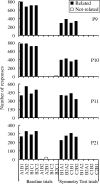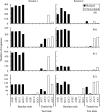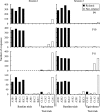Relational discrimination by pigeons in a go/no-go procedure with compound stimuli: a methodological note
- PMID: 22084498
- PMCID: PMC3213004
- DOI: 10.1901/jeab.2011.96-413
Relational discrimination by pigeons in a go/no-go procedure with compound stimuli: a methodological note
Abstract
A go/no-go procedure with compound stimuli typically establishes emergent behavior that parallels in structure and typical outcome that of conventional tests for symmetric, transitive, and equivalence relations in normally capable adults. The present study employed a go/no-go compound stimulus procedure with pigeons. During training, pecks to two-component compounds A1B1, A2B2, B1C1, and B2C2 were followed by food. Pecks to compounds A1B2, A2B1, B1C2, and B2C1 re-started the 30-s stimulus presentation interval. The absence of pecking to those compounds for 30 s ended the trial. Subsequent tests presented these components in new spatial arrangements and/or in recombinative compounds that together corresponded to conventional tests of symmetry, transitivity, and equivalence: B1A1, B2A2, C1B1, C2B2, A1C1, A2C2, C1A1, C2A2 vs. B1A2, B2A1, C1B2, C2B1, A1C2, A2C1, C1A2, C2A1 (positive vs. negative instances of symmetric, transitive, and equivalence relations). On tests for symmetric relations, all pigeons behaved in a manner consistent with training on both positive instances (i.e., by responding) and on negative instances (i.e., by not responding). By contrast, the pigeons' behavior on tests for transitivity and equivalence was inconsistent with baseline training, thus failing to show the recombinative discrimination performance that is typical of normally capable humans when trained and tested using the go/no-go procedure with compound stimuli.
Keywords: Go/no-go procedure; compound stimuli; key peck; pigeons; stimulus equivalence.
Figures





Similar articles
-
Stimulus control in a go/no-go procedure with compound stimuli with pigeons.Behav Processes. 2015 Jun;115:30-6. doi: 10.1016/j.beproc.2015.02.015. Epub 2015 Feb 23. Behav Processes. 2015. PMID: 25721532
-
Conditional relations with compound abstract stimuli using a go/no-go procedure.J Exp Anal Behav. 2007 Jan;87(1):89-96. doi: 10.1901/jeab.2007.46-05. J Exp Anal Behav. 2007. PMID: 17345953 Free PMC article.
-
Emergent conditional relations in a Go/No-Go procedure: figure-ground and stimulus-position compound relations.J Exp Anal Behav. 2009 Sep;92(2):233-43. doi: 10.1901/jeab.2009.92-233. J Exp Anal Behav. 2009. PMID: 20354601 Free PMC article.
-
A Review of Backward Higher-Order Conditioning: Implications for a Pavlovian Conditioning Analysis of Stimulus Equivalence.Perspect Behav Sci. 2023 Jul 20;46(3-4):493-514. doi: 10.1007/s40614-023-00385-y. eCollection 2023 Dec. Perspect Behav Sci. 2023. PMID: 38144547 Free PMC article. Review.
-
Comparative Cognition Research Demonstrates the Similarity between Humans and Other Animals.Animals (Basel). 2023 Mar 25;13(7):1165. doi: 10.3390/ani13071165. Animals (Basel). 2023. PMID: 37048420 Free PMC article. Review.
Cited by
-
Concurrent identity training is not necessary for associative symmetry in successive matching.J Exp Anal Behav. 2014 Jan;101(1):10-25. doi: 10.1002/jeab.51. Epub 2013 Sep 30. J Exp Anal Behav. 2014. PMID: 24436073 Free PMC article.
-
Cocaine use disorder in females is associated with altered social decision-making: a study with the prisoner's dilemma and the ultimatum game.BMC Psychiatry. 2019 Jul 5;19(1):211. doi: 10.1186/s12888-019-2198-0. BMC Psychiatry. 2019. PMID: 31277620 Free PMC article.
-
A replication and extension of the antisymmetry effect in pigeons.J Exp Anal Behav. 2012 Nov;98(3):283-93. doi: 10.1901/jeab.2012.98-283. J Exp Anal Behav. 2012. PMID: 23144506 Free PMC article.
-
A Neurocomputational Approach to Trained and Transitive Relations in Equivalence Classes.Front Psychol. 2017 Oct 18;8:1848. doi: 10.3389/fpsyg.2017.01848. eCollection 2017. Front Psychol. 2017. PMID: 29093696 Free PMC article.
-
ASSOCIATIVE CONCEPT LEARNING IN ANIMALS: ISSUES AND OPPORTUNITIES.J Exp Anal Behav. 2014 Jan;101(1):165-170. doi: 10.1002/jeab.62. Epub 2013 Dec 13. J Exp Anal Behav. 2014. PMID: 28386134 Free PMC article. No abstract available.
References
Publication types
MeSH terms
Grants and funding
LinkOut - more resources
Full Text Sources

